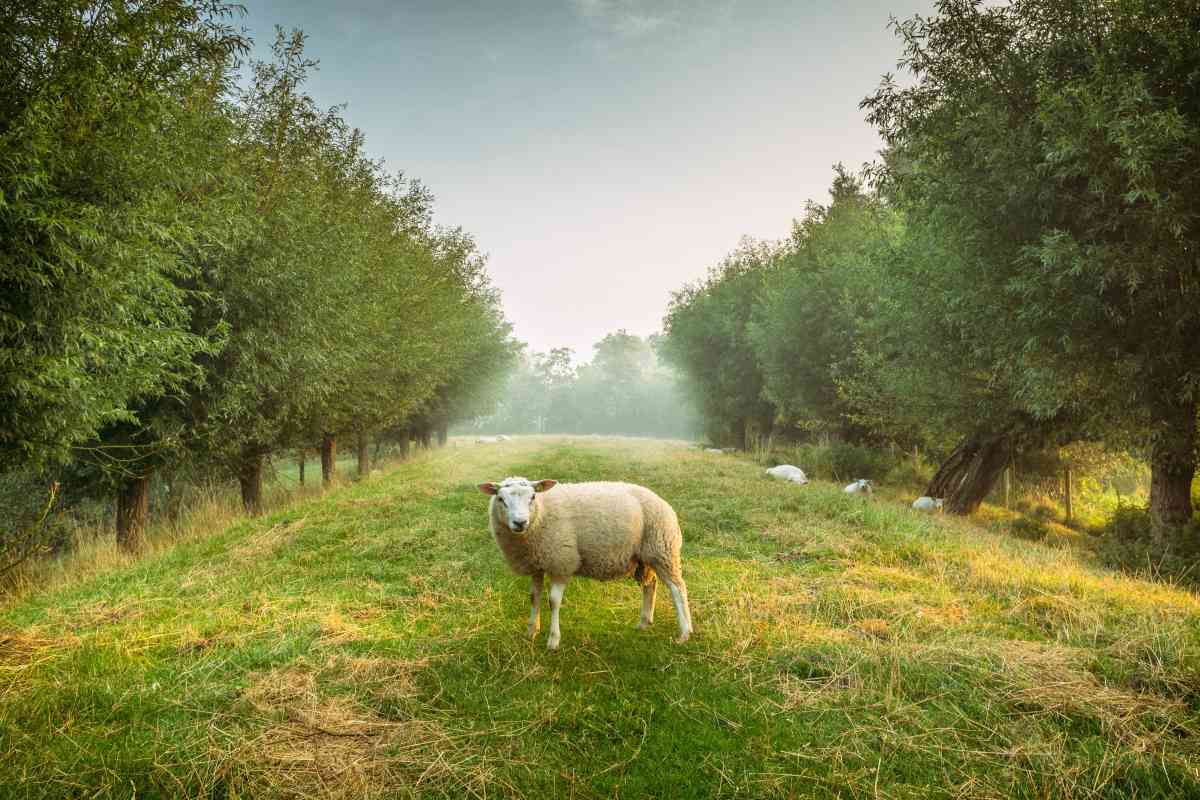Look no further if you’ve ever wondered how to tame a sheep and create a safe environment for you and the animal. In this concise guide, you’ll learn essential techniques for understanding sheep behavior, building trust, and training your sheep.
We’ve got you covered from the initial interaction to managing health and safety. So, grab your shepherd’s crook and prepare to embark on a journey of taming and nurturing these gentle creatures.
Safety comes first, always.
Understanding Sheep Behavior
You should observe how sheep interact with each other to understand their behavior. Sheep communication plays a crucial role in their social hierarchy. They use various vocalizations and body language to convey messages. For example, a dominant sheep may use headbutting or chasing to assert authority.
Understanding sheep’s instinctual behavior is essential for your safety. When sheep feel stressed, they may exhibit signs like pacing, excessive bleating, or even aggression. It’s necessary to be aware of these signals and give them space when needed.
Sheep body language can also provide valuable insights into their emotional state. Pay attention to their ear position, tail wagging, and overall posture to gauge their comfort level.
Preparing Your Environment for the Sheep
Have you considered how to create a safe and comfortable environment for the sheep? Preparing your space properly is crucial to ensuring the well-being of your sheep. Here are some critical steps to follow:
Providing shelter:
- Build a sturdy and weatherproof shelter where the sheep can take refuge from extreme weather conditions.
- Ensure proper ventilation and insulation to maintain a comfortable temperature inside the shelter.
Establishing boundaries:
- Install secure fencing around the grazing area to prevent the sheep from wandering off or entering dangerous situations.
- Regularly inspect the fencing for any damages or weak spots that need immediate attention.
Creating a calm environment:
- Minimize loud noises and sudden movements around the sheep’s living space to create a peaceful atmosphere.
- Avoid overcrowding the area, as it can cause stress and agitation among the sheep.
Introducing other animals:
- Gradually introduce other compatible animals, such as goats or chickens, to promote socialization and reduce loneliness.
Initial Interaction With Your Sheep
When approaching your sheep, it’s important to make gentle movements and use a calm tone of voice to establish a positive initial interaction. Gaining trust is crucial in building a bond with your sheep.
Approach them slowly and avoid sudden movements that may startle them. Speak in soothing tones to help them feel at ease. Setting boundaries is also essential for safety. Make sure they know your personal space by maintaining a comfortable distance.
Use positive reinforcement to reward good behavior, such as offering treats or gentle pats. Pay attention to your body language, as sheep are sensitive to non-verbal cues. Maintain eye contact, stand tall but relaxed, and avoid aggressive gestures.
Building rapport takes time, so be patient and consistent in your interactions.
Techniques for Building Trust With Sheep
To build trust with sheep, use patience, consistency, gentle handling, and positive reinforcement. Building rapport with your sheep is crucial for establishing a connection and creating a trust-based bond. Here are some techniques to help you gain their confidence:
- Spend time with your sheep regularly, allowing them to become familiar with your presence.
- Approach them calmly and slowly, using gentle movements and a soft voice to avoid startling them.
- Offer treats or rewards to reinforce positive behavior and associate your presence with something pleasant.
- Avoid sudden movements or loud noises that may cause them to feel threatened or anxious.
- Be consistent in your actions and routines, as sheep thrive on familiarity and predictability.
- Gradually introduce new experiences to help them adapt and build confidence.
Training Your Sheep: Basic Commands
With patience and consistency, you can train your sheep to respond to commands such as ‘come’ and ‘stay’.
Training techniques for sheep involve positive reinforcement and consistent repetition.
One effective method is clicker training, where you use a clicker to mark the desired behavior and reward the sheep with a treat. This helps them associate the sound of the clicker with a positive outcome.
Another technique is leash training, which involves gently guiding the sheep with a leash while giving the command.
Being patient and consistent when training your sheep is crucial, as they may take time to understand and respond to the commands.
Remember always to prioritize safety and carefully handle your sheep during training sessions.
The Role of Feeding in Taming a Sheep
You can successfully establish a positive association between feeding and taming your sheep by providing regular meals and using food as a reward.
Here are some feeding techniques and tips to help you in the process:
- Food Preferences
Sheep have different food preferences, so it’s essential to understand what they enjoy. Offer a variety of fresh hay, grass, and leafy greens to meet their nutritional requirements.
Gradually introduce new foods and observe their response to ensure they’re comfortable and enjoy their meals. - Feeding Schedule
Establish a consistent feeding schedule to create a sense of routine and security for the sheep.
Divide their meals into smaller portions throughout the day, providing a steady food supply.
Remember to use a rewards system during feeding time. This encourages positive behavior and reinforces the taming process. With patience and proper feeding techniques, your sheep will feel safe and develop a trusting bond with you.
Managing the Health and Safety of Your Sheep
Ensure the well-being and safety of your sheep by implementing proper health management practices. Identifying common sheep health issues is essential for early intervention and prevention. Regularly check your sheep for signs of illness or injury, such as weight loss, lameness, or abnormal behavior.
Implementing proper sheep nutrition is crucial for maintaining their health and preventing diseases. Provide a balanced diet with a mix of grass, hay, and grains and access to clean water.
Ensure a safe and secure sheep housing protects them from extreme weather, predators, and accidents. Regularly clean and disinfect their living area to prevent the spread of diseases.
Establish a regular sheep healthcare routine, including vaccinations, deworming, and hoof trimming, to prevent and manage sheep diseases effectively.
Overcoming Common Challenges in Sheep Taming
Don’t let fear hinder your progress in taming sheep; perseverance is key to overcoming common challenges.
Building confidence and handling fear are essential steps in the process. Here are some tips to help you establish boundaries, gain respect, and develop a routine with your sheep:
Building Confidence
- Start with small, manageable tasks to build your confidence gradually.
- Take the time to observe your sheep and understand their behavior patterns.
Handling Fear
- Approach your sheep calmly and confidently to avoid triggering fear.
- Use positive reinforcement techniques like treats or praise to create a positive association with your presence.
Your sheep will learn what’s expected of them by establishing clear boundaries. Gaining respect requires consistent and fair handling, allowing your sheep to trust and follow your lead.
Lastly, developing a routine helps create a sense of stability and predictability for your sheep, reducing their stress levels and making the taming process smoother.
Frequently Asked Questions
Can I Use the Same Techniques to Tame a Sheep as I Would With a Dog or Cat?
To tame a sheep, you need to use different techniques than with dogs or cats. Consider the challenges and understand the unique psychology of sheep. Patience and consistency are vital in building trust and a bond with them.
How Long Does It Typically Take to Build Trust With a Sheep?
Building trust with a sheep takes time. It requires bonding time, establishing a routine, and patience. Understanding the sheep’s behavior is crucial. Take the necessary steps to gain their trust and create a safe environment.
What Should I Do if My Sheep Becomes Aggressive During the Initial Interaction?
If your sheep becomes aggressive during the initial interaction, it’s important to stay calm and assess the situation. Understanding sheep psychology, establishing boundaries, and gaining their trust is essential. Techniques for handling aggressive sheep include using a firm but gentle approach and seeking professional assistance if needed.
Is It Necessary to Use Treats or Rewards During Training?
Using treats or rewards during training can be effective in taming a sheep. However, alternative methods like positive reinforcement can also work. Consider potential drawbacks and long-term effects before deciding which approach to take.
How Often Should I Be Feeding My Sheep During the Taming Process?
To establish trust and bond with your sheep, it’s important to feed them regularly but not excessively. Monitor their nutrition requirements signs of hunger or overfeeding, and establish a feeding schedule that best suits their needs.
Conclusion
In conclusion, taming sheep requires understanding their behavior, creating a suitable environment, and building trust through proper interaction and training.
Did you know that sheep have a strong sense of social hierarchy, with dominant individuals often taking charge? This statistic highlights the importance of establishing trust and leadership when taming sheep, creating a harmonious bond between you and your woolly friend.

